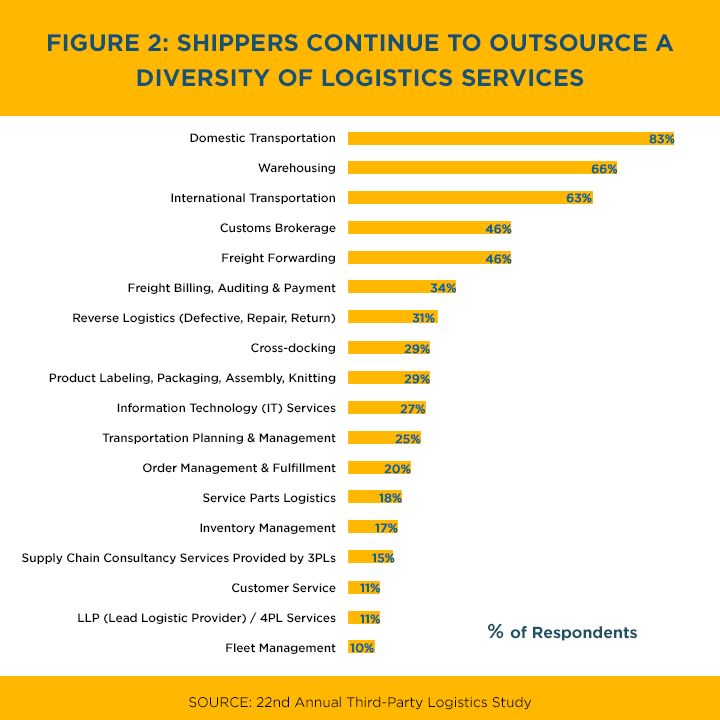Third-party logistics is a fancy name for a fulfillment house that helps online retailers and other types of businesses streamline the shipping and returns processes for their goods. By example, conglomerates like Amazon have their own well-established third-party logistics networks found in the many regional warehouses that are strategically located nationwide.
But for the millions of businesses that don’t have deep enough pockets to host their own logistics infrastructure, they instead rely on third-party logistics providers to regionally fulfill customer’s orders and to facilitate returns. Such warehouses enable smaller e-tailers to better compete by offering faster, cheaper shipping, easier, seamless returns and reduced operational overhead.
When it comes to returns, things can get complicated and tricky. Before we delve into how automation can resolve these complexities, let’s first take a deeper dive into the 3PL industry by learning about some key statistics.
Statistics on Third-Party Logistics
Here’s a closer look at some statistics about third-party logistics, so we can better understand how big this market is and why shippers are increasingly relying on outsourced fulfillment.
- By 2020, the 3PL market will be worth an estimated $935 billion, namely due to ecommerce outsourcing.
- Almost 97% of shippers want big data to be a part of their shipping and decision-making process as well as for advanced supply chain logistics.
- 75% of shippers use 3PL to reduce cost and improve logistics.
- 73% of shippers will check on their 3PL logistics at least once per day with many checking on their data by the hour.
- Cloud-powered 3PLs are proven to reduce cost, improve compliance, boost accuracy and streamline returns.
- 61% of shippers and 54% of 3PL providers agree that data sharing between each entity is a critical component to retention and long-term growth.
- 73% of 3PL users and 92% of 3PL providers agree that by working together, they’re improving overall logistics and efficiency.
- 61% of shippers are increasing their reliance on 3PLs, namely due to cost effectiveness, accuracy and reliability.

How Fulfillment Houses Work
Fulfillment houses are essentially logistics warehouses that ecommerce retailers and other businesses use to outsource the shipping and returns aspects of their business. They operate in profoundly simple and logical manner (a massive guide on this is available at Fits Small Business).
- The e-tailer signs an agreement with the fulfillment house and sends them the inventory they need fulfilled. Typically, this is done via a purchase order with a delivery address of the fulfillment house, which is authorized to sign off for receipt of the shipment. Or when goods are self-manufactured, they’re directly shipped to the fulfillment house.
- The fulfillment company then sorts, organizes and stocks the inventory they’ve received, entering this data into their inventory management system for proper tracking.
- When customers place online orders, those orders are then routed, typically via an API and cloud-based software, to the fulfillment house.
- The fulfillment house then sorts and manages the outbound orders, shipping them on behalf of the retailer and charging them a fee for their services.
- If a product is returned, it generally comes back to the fulfillment house, where it’s logged, and either restocked or sent back to the retailer if it’s unable to be resold post return.
How 3PL Returns Work
The disconnect with fulfillment houses is when returns happen. Certainly, fulfillment houses are capable of handling returns. But when there are multiple clients involved, returns can get tricky, especially if some of those clients have high-volume return items, like apparel, which has a 35% return rate in ecommerce.
In most cases of 3PL returns, the returns are scanned in and set aside to be later sorted. The retailer (customer) isn’t usually made aware of what’s been returned until well after the fact, usually when a stock clerk has had time to examine the return, log it, update the system, update the retailer and determine if the return can be restocked.
Once that return has been logged, it’s added to an end of the month report that’s sent out to the retailer (these reports may be more frequent depending on the 3PL provider). The necessary amount of human touches, clerical entries and the accuracy issues they create typically bogs down busy fulfillment houses and eats into their bottom line.
What’s more, the retailer can be in the dark about their returns for weeks at a time, never knowing what their true profit margins were until they consolidate multiple reports from the 3PL provider.
Why Automation is the Key
Automation of these third-party returns is the key to logistical success for all parties involved in the process. With the right system automating the return, the third-party logistics provider minimizes human touches, improves accuracy, reduces cost and keeps the retailer updated in real-time.
How might this be possible? Take a look at ReadyReturns ecommerce returns software, it’s a premium plugin for the ReadyCloud Suite. ReadyReturns is the preferred 3PL returns software for today’s leading 3PL providers. That’s because it connects to the ReadyCloud Suite, giving both the 3PL provider and the retailer real-time insights into what’s being returned, what fees were charged, and whether or not the product can be restocked.
Furthermore, ReadyReturns can handle as many different clients as possible, separating them into individual profiles for the 3PL. What this means is that the 3PL can access all their clients from one dashboard (clicking into each client they need to scan and process a return for), meanwhile the retailer (client) has real-time access to a white label dashboard that keeps them up to date.
How can ReadyReturns streamline your third-party logistics? Give us a call to schedule your complimentary live demo today. Shipping with UPS? Your warehouse and your clients may qualify for ReadyReturns at full or partially subsidized pricing. Find out how. Call us at: 877-818-7447.